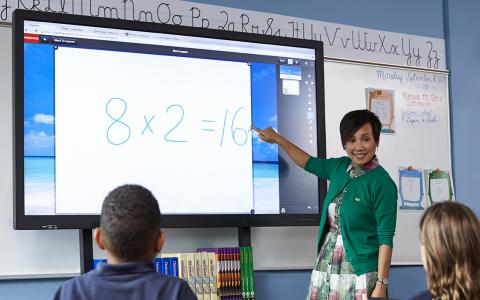The education system is the bedrock of any society, shaping the future of nations through the development of its youth. However, in an ever-evolving world, the question arises: Does our education system need reform? The answer, in many cases, is a resounding “yes.” In this article, we’ll explore the need for educational reform and the role of Interactive Flat Panel Displays (IFPDs) in reshaping the way we teach and learn.
The Imperative for Reform
Before delving into the role of IFPDs, let’s understand why reform is essential in education:
- Preparing Students for the Modern World:
The world is changing at an unprecedented pace, driven by technological advancements, globalisation, and evolving societal needs. To thrive in this dynamic environment, students must be equipped with skills that go beyond rote memorization. They need critical thinking, problem-solving abilities, creativity, and adaptability – skills that traditional education systems often fail to nurture adequately.
- Bridging the Digital Divide:
Technology has become a fundamental part of our daily lives. Yet, many educational institutions still lag behind in integrating technology into their teaching methods. This digital divide can leave students unprepared for the realities of the modern workforce, where digital literacy is a prerequisite.
- Encouraging Lifelong Learning:
Education shouldn’t be confined to the years spent in formal institutions. The ability to learn, unlearn, and relearn is critical in an era of rapid change. Educational systems should instil a love for learning that extends beyond the classroom and continues throughout life.
- Fostering Inclusivity:
Education should be inclusive, providing opportunities for all, regardless of socio-economic background, physical abilities, or geographic location. Unfortunately, many education systems perpetuate inequality and disadvantage.
The Role of Interactive Flat Panel Displays (IFPDs)
IFPDs are powerful tools that can play a significant role in educational reform. Here’s how they address the imperatives mentioned above:
- Active Learning and Critical Thinking:
IFPDs enable active learning. With these interactive displays, students can engage with the content directly. They can solve problems, collaborate on projects, and explore subjects independently. This fosters critical thinking and problem-solving skills, which are vital in the modern world.
- Bridging the Digital Divide:
IFPDs bridge the digital divide by making technology an integral part of the classroom experience. They provide access to digital resources, interactive lessons, and multimedia content. By using IFPDs, students become more familiar with digital tools and resources, preparing them for the digital age.
- Lifelong Learning:
IFPDs encourage a love for learning. These interactive tools make education engaging and dynamic, motivating students to explore and discover. With IFPDs, learning is not limited to the four walls of a classroom but extends to the digital world, where information is abundant and accessible.
- Fostering Inclusivity:
IFPDs support inclusivity in education. Their interactive nature accommodates different learning styles and abilities. The digital platform allows for customization, ensuring that students with diverse needs can access and engage with the content effectively.
A Modern Classroom with IFPDs
Imagine a classroom equipped with IFPDs. In this modern learning environment:
- Teachers facilitate active learning, where students participate and engage with the content directly.
- Multimedia elements like videos, animations, and interactive applications are seamlessly integrated into lessons, making complex topics more accessible.
- Collaborative learning is the norm, with students working together on projects, problem-solving, and sharing ideas on a digital canvas.
- Assessment and feedback are efficient, with automated grading systems providing immediate insights into student performance.
- The digital divide is minimised as students become familiar with technology and digital resources.
Conclusion
Our education system is at a crossroads. The imperatives for reform are clear, as we need to prepare students for the modern world, bridge the digital divide, foster lifelong learning, and ensure inclusivity. Interactive Flat Panel Displays (IFPDs) play a vital role in addressing these imperatives by transforming the traditional classroom into a dynamic, engaging, and inclusive learning environment.
The reform of our education system must embrace technology like IFPDs to ensure that students are adequately prepared for the challenges and opportunities of the digital age. These tools bridge the gap between traditional and modern education, fostering a love for learning, critical thinking, and digital literacy. As we move forward, it’s essential that educational institutions, policymakers, and educators embrace these transformative technologies to shape the future of education for the better. Education reform is not a choice; it’s a necessity for the progress of individuals and societies alike.






